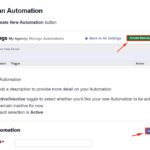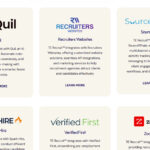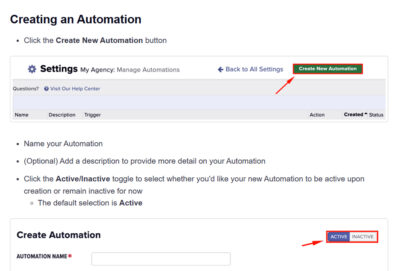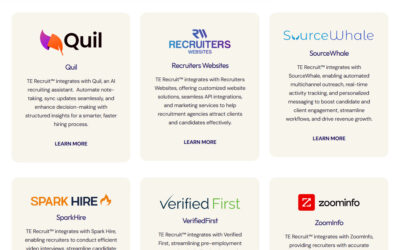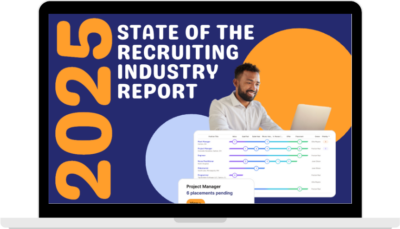(Editor’s note: The information from this article by Top Echelon Recruiting Software has been taken from an Expert Recruiter Coaching Series webinar by Steve Gipson of Recruiters Websites titled, “SEO Fundamentals of Recruiting” Click HERE to watch the video of that training webinar for free.)
In the world of recruiting, visibility is currency. You can have the best client relationships, a rockstar candidate pipeline, and a killer value proposition—but if people can’t find you online, you’re invisible. In today’s digital-first world, visibility equals credibility, and that’s where SEO (Search Engine Optimization) enters the chat.

Most recruiters still rely on cold outreach, referrals, and personal branding. While those strategies still work, ignoring SEO means you’re leaving a powerful source of inbound leads untapped.
In a dense but insightful webinar titled “SEO Fundamentals of Recruiting,” Steve Gibson, Director of Sales and Operations at Recruiters Websites, along with Emily, the firm’s Marketing Manager, laid out what every recruiter needs to know about getting found online.
This article distills that wisdom into a playbook. No jargon. No fluff. Just the essential tactics to help recruiters get discovered—and dominate their niche in search.
What Is SEO, Really?
SEO stands for Search Engine Optimization. It’s the process of improving your website so that it appears higher in organic (unpaid) search engine results for relevant queries.
That might sound basic, but many recruiters don’t see the full picture.
“SEO is all about helping search engines understand what your website is about,” says Steve Gibson. “So when someone searches for a phrase that matches your expertise—like ‘manufacturing recruiters’—your site is what Google decides to show.”
In other words: SEO makes sure your digital storefront is visible when it matters most—when someone is actively looking for what you do.
And the stakes are high. According to industry data cited in the webinar, 53% of all web traffic comes from organic search.
“If you’re not showing up in those results, you’re essentially invisible to more than half the people looking for your services online,” Gibson adds.
Organic vs. Paid: Understanding the Search Results Page
One common misconception is that you need to pay to appear on Google. Not true.
Paid search ads appear at the top and bottom of Google’s results pages and are labeled as “Sponsored.” These are placed through advertising platforms like Google Ads and charge you per click.
SEO, on the other hand, is about earning those placements organically.
Gibson explains the difference this way: “Organic rankings are earned. They’re based on your content, your keywords, and the quality of your website. Nobody paid to be there.”
While paid advertising can be valuable, Gibson emphasizes that organic SEO offers long-term, cost-effective results.
“An ad stops working the second you stop paying for it. A well-optimized blog post? That can drive traffic and leads for years.”
Yes, Clients Are Searching for You
Many recruiters believe that SEO doesn’t apply to them because they’re the ones doing the outreach—not the other way around.
That’s a half-truth.
“Recruiters will tell me, ‘Steve, my clients don’t search for recruiting firms online.’ But they’re wrong. The data doesn’t lie,” Gibson says.
He shared keyword research showing that niche phrases like “manufacturing recruiters” get over 350 monthly searches, while “recruiters” alone gets over 1,000 per month.
“These are real people, typing real queries into Google, looking for firms just like yours,” he continues. “And if you’re not optimized, someone else is getting those calls.”
Even if you rely mostly on outbound, SEO gives your brand credibility. When someone Googles your name or niche, they should see more than a basic site—they should see a thought leader.
How Search Engines Decide Who Ranks
So how does Google choose which websites appear first?
According to Gibson and Emily, it comes down to three core factors:
-
Relevance – Does your page match the search intent?
-
Authority – Are other reputable sites linking to you?
-
Usefulness – Is the content helpful, well-organized, and user-friendly?
Google’s algorithm also weighs technical aspects, such as:
-
Page load speed
-
Mobile optimization
-
Secure browsing (SSL certificate)
-
Clean URL structure
-
Image optimization
-
Heading hierarchy (H1, H2, etc.)
-
Internal and external linking
-
Content freshness
“Google tracks everything,” says Gibson. “How fast your site loads, whether people stick around or bounce, even how often you update it.”
It all adds up to a simple truth: SEO is a holistic game. You can’t just stuff a few keywords into a page and hope for results. Everything matters.
Three Types of SEO Every Recruiting Firm Needs
1. On-Page SEO
This is what you control directly on your website: keyword usage, metadata (titles/descriptions), headlines, images, and overall page structure.
2. Off-Page SEO
This includes external factors like backlinks from other sites, social shares, reviews, and media mentions. For example, if you’re named a top firm by Forbes or have a guest blog post on another site, that builds authority.
3. Technical SEO
This covers the backend elements: site speed, mobile responsiveness, proper code structure, no broken links, clean URLs, and a crawlable sitemap.
“For most recruiters, on-page SEO is the best place to start,” says Gibson. “That’s the part you can control right now without needing a developer.”
The Power of Metadata: Titles & Descriptions
Metadata refers to the title and description that appear in search results.
Here’s an example:
Title: Tech Recruiting Firm | ABC Search Group
Meta Description: ABC Search connects top software engineers with fast-growing startups. Find your next hire today.
According to Gibson, optimizing metadata is “one of the most important—and most overlooked—things you can do.”
“If you haven’t set your own metadata, Google is probably just pulling in the first sentence of your page, which doesn’t help anyone,” he says.
Use tools like Yoast (for WordPress) or built-in editors on platforms like Wix or Squarespace to customize metadata for each page. Be sure to include your target keyword.
Creating Content That Actually Ranks
Content is the foundation of SEO. But it needs to be both valuable to humans and optimized for search engines.
Gibson offers this formula:
-
Use the target keyword in the title, intro, subheadings, and conclusion.
-
Sprinkle in variations and synonyms throughout the content.
-
Add “semantic” keywords—terms that relate to your niche and show Google you’re an expert.
For example, if you’re optimizing for “insurance recruiters,” include terms like “claims adjusters,” “underwriting,” “P&C,” and “carrier networks.”
But beware of overdoing it.
“Keyword stuffing is dead,” says Gibson. “If your content doesn’t read naturally, people will bounce—and Google will notice.”
Blogs & Industry Pages: Two SEO Workhorses
Blog posts and industry-specific pages are among the best tools to expand your site’s visibility.
“Think of blogs as ongoing answers to client and candidate questions,” says Gibson. “They’re great for ranking on long-tail keywords.”
Sample blog titles:
-
“Top Interview Questions for Manufacturing Managers”
-
“How to Recruit Passive Sales Talent”
-
“The Real Cost of a Bad Hire in Accounting”
Meanwhile, industry pages serve as niche landing pages that can outrank your homepage for specific searches.
If you recruit in logistics, for example, you might create a page called /logistics-recruiters with focused content, testimonials, and a lead form.
“These pages do double duty,” Gibson explains. “They attract traffic, and they convert because the messaging speaks directly to that audience.”
Long-Tail Keywords: The Hidden Goldmine
Don’t try to rank for “recruiter.” That’s a losing game dominated by billion-dollar firms.
Instead, go after long-tail keywords—longer, more specific phrases that have less competition but higher intent.
Examples:
-
“Accounting executive recruiter in Denver”
-
“Healthcare staffing agency for RNs”
-
“Retained biotech search firm Boston”
Even if these terms only get 10–50 searches per month, they can yield high-value results.
“If one ideal client finds you and signs a $25,000 fee agreement, does it matter that only 10 people searched that term?” Gibson asks. “That’s the power of long-tail keywords.”
Use tools like Google Keyword Planner, SEMrush, or Ahrefs to find these hidden opportunities.
Technical SEO: Don’t Ignore the Backend
Gibson shared a quick checklist of technical must-haves for recruiter websites:
-
SSL certificate (HTTPS)
-
Mobile-friendly design
-
Fast page load times (<3 seconds)
-
Clean URLs (e.g.,
/sales-recruiters, not/?id=123) -
Working internal and external links
-
Proper image optimization with alt text
-
Clear heading hierarchy (H1, H2, etc.)
You can use free tools like Google PageSpeed Insights, GTMetrix, or Screaming Frog to audit your site.
“Most of this doesn’t require a developer,” Gibson says. “But if your site has broken links or slow load times, it will hurt your rankings.”
Jobs as Content: Maximize SEO Value
Many recruiters miss a huge opportunity: their job listings.
“If your job postings are on your site with unique URLs, they can help your SEO tremendously,” Gibson explains.
But be careful—many ATS platforms use iframes or branded portals that don’t generate SEO value. What you want are job listings that look like:
/jobs/project-manager-st-louis
That way, each posting is a separate page that Google can index.
Even if the job is filled, keep the listing up and simply mark it as closed. It’s still valuable content for search engines and users.
Google Business, Social Media and Off-Site SEO
Gibson emphasized the importance of Google Business Listings and social profiles.
“Your Google listing might rank higher than your website,” he says. “So make sure it’s complete and accurate.”
Set up (or claim) profiles on:
-
Google Business
-
LinkedIn (business page)
-
Facebook (business page)
-
Twitter/X, Instagram (even if not used actively)
Ensure consistent business info across all platforms (name, address, phone number, website).
“Even if you’re not posting every day, just claiming the page helps you appear more legitimate—and improves your chances of ranking,” Gibson adds.
Embracing AI & Google’s Future
Google is beginning to roll out AI-generated answers within search via its Search Generative Experience (SGE).
These results will be powered by quality content, not keyword tricks.
“That’s why E-A-T is more important than ever,” says Gibson, referencing Google’s framework for Expertise, Authority, and Trustworthiness.
Focus on producing detailed, niche content that answers specific questions. Clarity and value will win in both traditional search and AI-powered interfaces.
Getting Started: What You Can Do Today
No tech skills? No problem. Here are simple action steps from Gibson to improve your SEO now:
-
Claim your Google Business profile
-
Create/complete your LinkedIn company page
-
Set up Google Analytics & Google Search Console
-
Install Yoast on your WordPress site
-
Identify 3–5 long-tail keywords for your niche
-
Customize metadata for each website page
-
Write one new blog post per month
-
Add or improve your niche industry pages
-
Test site speed and fix broken links
-
Make sure job listings have unique, crawlable URLs
Final Thoughts: The Long Game Pays Off
SEO isn’t a quick fix. It’s a long-term investment in digital visibility and brand authority. But if you play it smart and consistent, it pays massive dividends.
“Most recruiters don’t even touch this stuff,” Gibson concludes. “That means the ones who do have a real opportunity to stand out—and get found.”
If you want to be more than just another recruiter with a nice website, it’s time to put that site to work.
Get found. Get leads. Make placements.
Need Help?
Visit RecruitersWebsites.com or email Steve Gibson at steve@recruiterswebsites.com.
He’s happy to share advice, tools, or even build a fully optimized site that brings inbound traffic straight to your desk.



